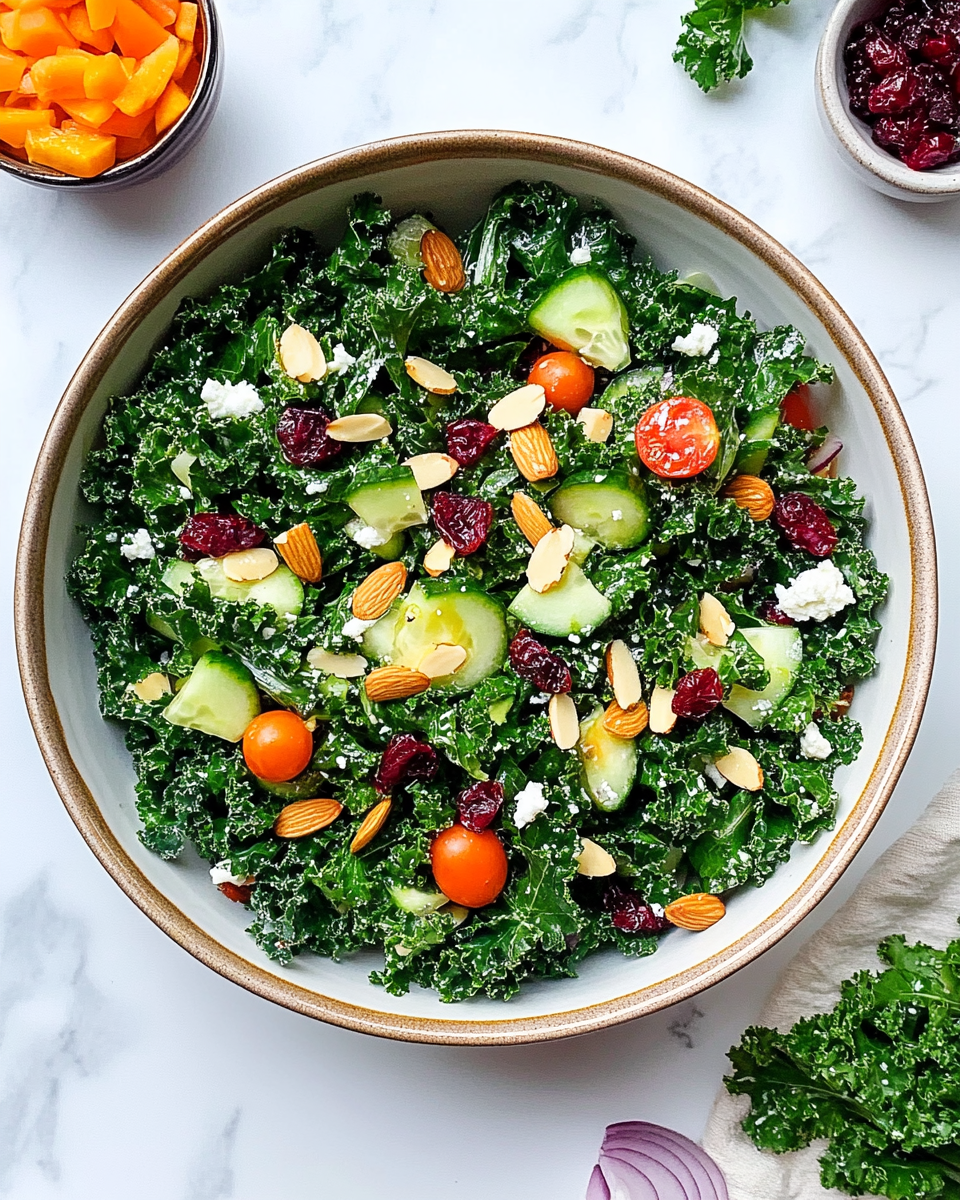This kale salad is vibrant, nutrient-packed, and bursting with fresh flavors. It combines crispy kale, sweet fruits, and a zesty dressing for a refreshing, healthy dish that’s perfect for any meal or as a side.
FULL RECIPE
Ingredients
- 1 bunch of kale, stems removed and leaves torn into bite-sized pieces
- 1 cup cherry tomatoes, halved
- 1/2 cup cucumber, thinly sliced
- 1/4 cup red onion, thinly sliced
- 1/4 cup shredded carrots
- 1/4 cup sliced almonds
- 1/4 cup dried cranberries
- 1/4 cup crumbled feta cheese (optional)
Directions
- Wash and dry the kale thoroughly. Remove any tough stems and tear the leaves into bite-sized pieces.
- Place the kale in a large bowl and massage it with your hands for 2-3 minutes to soften the leaves.
- Add the cherry tomatoes, cucumber, red onion, shredded carrots, sliced almonds, dried cranberries, and feta cheese (if using) to the bowl.
- Drizzle with your favorite dressing (a lemon vinaigrette or balsamic vinaigrette works great).
- Toss everything together until the salad is evenly coated with the dressing.
- Serve immediately or refrigerate for up to 2 hours before serving.
Nutritional Information
- Calories: 200-250 per serving
- Protein: 5g
- Carbs: 20g
- Fiber: 4g
- Fat: 15g (primarily from almonds and feta cheese)
- Sugars: 10g
The Health Benefits of Kale
Kale is often referred to as a superfood due to its impressive nutrient profile. It’s loaded with vitamins A, C, and K, and provides a good amount of fiber and antioxidants. Eating kale regularly can support your immune system, promote healthy skin, and even help improve bone health. It’s also rich in iron, which is crucial for energy production and maintaining a healthy metabolism.
Why Choose Fresh Kale for Your Salad
When you use fresh kale, you’re ensuring that your salad is as nutritious as possible. Fresh kale retains more of its beneficial nutrients compared to pre-packaged versions that might have lost some of their freshness during transport and storage. It also provides a more robust flavor and crunch, which can elevate the overall texture of the salad.
How to Prepare Kale for Salad
Before using kale in your salad, it’s important to properly prepare it. Start by removing the tough stems, which can be bitter and hard to chew. Tear the leaves into smaller pieces and wash them thoroughly to remove any dirt or pesticides. Once cleaned, massage the kale leaves with your hands for a few minutes. This helps break down the fibers, making it more tender and less bitter, which makes the salad more enjoyable.
The Role of Dressing in Kale Salad
Dressing plays a crucial role in kale salad by enhancing its flavor and helping to balance out the bitterness of the kale. A good dressing will complement the freshness of the vegetables and other ingredients, adding an extra layer of richness and tang. Lemon vinaigrette or balsamic vinaigrette are popular choices, as their acidity helps to soften the kale leaves while also bringing out the sweetness in other ingredients.
Adding Fruits to Your Kale Salad
Incorporating fruits into your kale salad adds natural sweetness and variety. Fruits like apples, oranges, or pomegranate seeds can create a perfect balance with the earthiness of kale. The sweetness of fruits also contrasts beautifully with savory elements like nuts, cheese, and vinegar-based dressings, making every bite more exciting and complex.
The Benefits of Using Almonds
Almonds are an excellent source of healthy fats, protein, and fiber, making them an ideal addition to a kale salad. They not only enhance the texture with their crunch but also provide a nutty flavor that pairs well with the earthiness of kale. The fats in almonds can help you feel full longer and provide sustained energy, making your salad more satisfying.
Incorporating Dried Cranberries for a Sweet Touch
Dried cranberries are a perfect addition to kale salads as they introduce a burst of sweetness and a chewy texture. They’re also a great source of antioxidants, which can support your immune system and improve overall health. The tartness of cranberries adds a nice contrast to the salad’s other ingredients, balancing out the more savory components.
The Role of Feta Cheese
Feta cheese adds a creamy, tangy flavor to kale salads, providing richness without overwhelming the other ingredients. It also introduces a savory element that contrasts nicely with the sweetness of fruits and cranberries. While feta cheese is optional, it can make the salad feel more indulgent while still being relatively healthy, as it’s lower in fat than many other cheeses.
The Versatility of Kale Salad
One of the best things about kale salad is its versatility. You can add a wide variety of ingredients to suit your taste preferences or what you have on hand. Try experimenting with different nuts, seeds, fruits, and even grains like quinoa or farro. You can also adjust the dressing to match the flavor profile you’re going for, whether it’s tangy, creamy, or sweet.
How to Make Your Kale Salad a Complete Meal
By adding more protein-rich ingredients like grilled chicken, tofu, or chickpeas, you can turn your kale salad into a filling meal. These additions not only increase the protein content but also help balance the dish, making it more satisfying and nutritious. Don’t forget to add a healthy fat source like avocado or olive oil to further enhance the meal’s nutritional value.
How to Store Leftover Kale Salad
If you have leftover kale salad, you can store it in an airtight container in the refrigerator for up to 2 days. However, if you’ve already added dressing, it’s best to eat the salad within a few hours for optimal freshness. To avoid sogginess, store the dressing separately and only add it just before serving.
Making Kale Salad for Meal Prep
Kale salad is an excellent choice for meal prep, as it holds up well in the fridge for several days. Prepare a large batch and divide it into individual servings, storing them in airtight containers. When ready to eat, just add your dressing and enjoy. You can also prepare the salad ingredients separately and assemble them as needed to keep everything fresh.
Kale Salad as a Side Dish
This kale salad makes a fantastic side dish for almost any main course. It pairs well with grilled meats, roasted vegetables, or pasta dishes, adding a refreshing and nutritious element to your meal. Its vibrant colors and flavors will brighten up any plate, making it a visually appealing addition to your table.
The Importance of Balancing Flavors
When creating a kale salad, it’s essential to balance the flavors to ensure it’s harmonious. The earthiness of kale pairs well with sweet fruits, tangy dressings, and savory ingredients like cheese and nuts. Consider your ingredients carefully to create a dynamic salad that’s both satisfying and delicious, with a variety of textures and tastes in every bite.
Seasonal Variations of Kale Salad
Depending on the season, you can customize your kale salad to feature different fruits and vegetables. In the summer, try adding fresh berries, peaches, or cucumbers, while in the winter, roasted root vegetables like sweet potatoes or beets can add warmth and depth. Seasonal ingredients keep the salad exciting and relevant throughout the year.
How Kale Salad Supports Digestive Health
Kale is an excellent source of fiber, which plays a key role in supporting healthy digestion. The fiber in kale helps keep your digestive system running smoothly by promoting regular bowel movements and preventing constipation. The addition of other fiber-rich ingredients, such as nuts and dried fruits, further supports digestive health.
Making Kale Salad More Flavorful with Spices
Adding spices to your kale salad can elevate its flavor profile. Consider sprinkling a bit of cumin, chili flakes, or paprika on top to add warmth and depth. Spices can bring a whole new dimension to the salad, making it feel more like a gourmet dish without being complicated to prepare.
The Environmental Benefits of Kale
Kale is a sustainable and eco-friendly choice for your diet. It is relatively easy to grow, requiring fewer resources like water and fertilizer compared to other leafy greens. By incorporating more kale into your meals, you’re not only benefiting your health but also supporting environmentally friendly farming practices.
Advertisement
Kale Salad for Weight Management
Kale salad is a great option if you’re trying to manage your weight. It’s low in calories but high in nutrients, making it a filling and satisfying choice for those looking to maintain or lose weight. The fiber in kale helps promote satiety, reducing the likelihood of overeating during meals.
The Importance of Using Organic Kale
When possible, it’s a good idea to choose organic kale for your salad. Organic kale is grown without the use of synthetic pesticides or fertilizers, making it a healthier and more environmentally friendly option. It also tends to have a more robust flavor and is more nutrient-dense than conventionally grown kale.
Conclusion
Kale salad is a delicious and versatile dish that can be enjoyed in numerous ways. With its vibrant flavors, crunchy textures, and health benefits, it’s no wonder this salad is a favorite among health-conscious eaters. By customizing your kale salad with different fruits, nuts, and dressings, you can create a meal that’s as unique as it is nutritious. Whether you’re looking for a light side dish or a hearty main course, kale salad is the perfect choice for any occasion.






